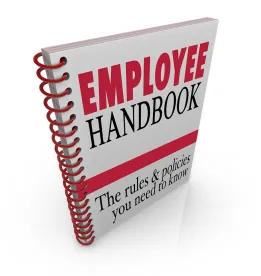Multistate employers often face the difficult task of finding the most effective way to prepare their handbooks while ensuring compliance not only with federal law, but also with the applicable state, local, and even international laws of the jurisdictions in which they operate. As many multistate employers continue to grow and expand their footprints both nationally and internationally, and as remote work becomes more common across industries, this is one of the challenges they are facing, especially where state laws are quickly evolving.
What Is an Employee Handbook?
Although employee handbooks are not legally required, employers often use them as a welcome tool to communicate policies, procedures, behavioral expectations, and working conditions to new and existing employees. The handbook is often a document that establishes important policies and information that protects the rights of both employers and employees, and it can be an effective communication tool for employers to meet their legal notice requirements. For multistate employers, this may be challenging to achieve in one comprehensive handbook as many states and localities frequently have differing laws and requirements—with some constantly changing even before the ink is dry on employee handbook updates.
Will a One-Size-Fits-All Employee Handbook Work?
In general, employee handbooks are not typically “one-size-fits-all” documents. All employers may want to consider tailoring their employee handbooks based upon industry, number of employees, union/non-union status, and whether they are government contractors or public- or private-sector employers. Likewise, multistate employers may want to make sure their employee handbooks are compliant with applicable state and local laws where their employees are physically located, sent to work on assignments, or working remotely. Many employers use a “form” employee handbook that usually follows federal law requirements. Nevertheless, there are often many policies that may need to be adjusted depending upon the state or locality of operations, including but not limited to policies related to paid/unpaid medical leave, paid time off, jury duty, protected characteristics, witness leave, lactation breaks, wage payments, and weapons, just to name a few. Thus, multistate employers determine the best way to communicate state law variations to their employees in order to explain workplace expectations while complying with applicable state law requirements.
How Can Multistate and International Employers Meet Their Legal Obligations?
Nationally, some multistate employers choose to use a master “generic” handbook that complies with federal law. Along with the master “generic” handbook, multistate employers provide employees with state-specific addenda laying out the applicable state law and/or local requirements of the locations where the employees are employed. This way, when state or local laws change, the master “generic” handbook need not always be revised. Other employers simply use a master handbook that includes the most generous policies and benefits of any state in which they operate. Under this method, however, employees may be provided greater benefits and protections than those required by the actual states in which they are employed. Finally, some employers simply choose to prepare a separate handbook for each state in which they operate.
Employers with international workforces also often want to use their U.S. handbooks globally, with the important goal of making all their employees around the world feel part of the same team. But, just as there are state-specific laws in the United States, jurisdictions outside the United States have their own laws. This means that any global handbook would likely have to be quite general—perhaps with a welcome message, information about the corporate group of companies, and a code of conduct that could be applicable anywhere. Then, all country-specific information could be contained in individual country addenda, similar to state-specific addenda included in U.S. handbooks. In addition, some countries have multiple jurisdictions with different laws, such as the provinces of Canada or cities in China. Having a jurisdiction-specific addendum would make for a more user-friendly—and legally compliant—experience for employees, no matter where they work.
Other issues for employers to watch out for internationally include inadvertent potential bases for joint-employer claims if it is unclear as to which entity is promulgating and enforcing the rules in each jurisdiction. In addition, under the relevant laws of each jurisdiction, the handbook and particular addendum would likely have to conform with and not contravene employment contracts and collective bargaining agreements (which are often industry-wide), the handbook might have to be written in the local language to be enforceable, and “Work Rules” in some countries are highly regulated and must be registered with the local labor office.
Finally, employers may want to understand and embrace cultural differences when formulating handbook policies in order to demonstrate that they are not seeking arbitrarily to impose U.S.-centric rules but have rather taken local laws and sensibilities into consideration. A global handbook can be a great introduction to the global brand, so with good planning, the final product can prove truly useful to a group of employees and convey the right tone from the top.
In sum, multistate and multi-country employers may want to choose the option that works best for them, taking into consideration factors such as the states and countries in which they operate, the number of employees in each state or country, and the availability of human resources support to ensure compliance with policies.





 />i
/>i

